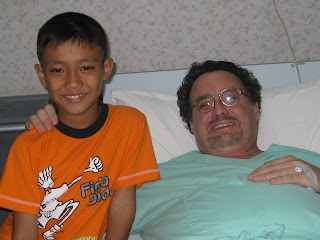Attending the training were about thirty-five foreign English teachers representing: Canada, U.S., England, Ireland, The Philippines, Zimbabwe, Germany, Malaysia, Australia, Belgium, China and Croatia. It was a rare pleasure to be able to network with some of these teachers from such diverse backgrounds, and I walked away from the three-day training with a fair amount of new ideas as well as a few new friends.
I didn’t quite know what to expect from the Thai culture module but found it one of the more interesting components of the training if not the most confusing. Our first presenter, Ms. Puthachad Sucharitakul, luckily asked us to address her as “Sheena,” which was a helluva lot easier than trying to pronounce her Thai name. She was extremely informative and thorough (as well as very easy on the eye), walking us through various sub-headings such as: A General Knowledge of Thailand, Thai History, Thai Politics and Governance, Thai Ways of Life, Cross-cultural Values, and Thai Arts and Music.
Topics covered under “Thai Ways of Life,” were the Traditional Thai Social System, Thai Nature, Hierarchical Society, Thai Smile, Thai Tolerance, Sense of Safety and the very interesting and humorous, “Trying to Do Things Even When We Do Not Understand.” I found “Thai Ways of Life” the most difficult to understand as did many other foreign teachers from the West.
Having been educated in the U.S., Sheena had an excellent command of the English language as well as an in-depth knowledge of Thailand from her life growing up in Bangkok. She struggled, however, to explain the more complex underpinnings of Thai life, and several times resorted to offhand comments such as, “I realize this doesn’t make sense,” or “…which is totally non-productive,” leaving many of us (Westerners especially) with the feeling that “Thai Ways of Life,” were akin to shooting oneself in the foot. But, having lived in Thailand for four years, I felt I now understood things a little better after attending this course.
The topic, “Trying to Do Things Even When We Do Not Understand,” got just about everybody laughing, since any foreigner who has lived in Thailand for any length of time has undoubtedly encountered this phenomenon. The example given in class was the typical case of the lost farang and the ever-present tuk-tuk or motorcycle taxi driver eager to take him or her to their destination for a price (usually elevated above what a Thai would be charged):
Farang: “Sawasdee krab. Can you take me to the Royal Crown Hotel?”
Tuk-tuk or Motorcycle taxi driver: “Hah?” (Replete with puzzled look).
Farang: “Can you take me to the Royal Crown Hotel? The HO-TELL, ROY-ALL CR-OW-UN HO-TELL.” (For some odd reason, we foreigners think talking slower and louder makes the person we are talking to understand even though they cannot speak English).
Thai driver (Smiling widely and nodding profusely): “Ah! Yes, yes!”
Farang: “Thao rai?” (How much?)
Thai driver: Sam sip baht (Thirty baht – High farang price)
Farang (Looking annoyed but in a hurry): “Hum! Okay (Replete with frown).
Then, after about five minutes of convoluted twists and turns through narrow streets and heavy traffic, you arrive at…
A department store.
Why?
It’s one of the more simplistic and understandable absurdities in Thailand actually. The driver had no clue what you were asking or saying, but rather than admit he doesn’t understand (which is somewhat akin to losing face) he takes you to some destination that is his best guess as to where you want to go, probably based on where other farangs have asked him to go.
Day-two covered professional ethics and was presented by Miss Woramon Chulacharit, who for the life of me, for the first five minutes or so, I could not understand even though she was speaking English.
Eventually I began to understand once I focused on her Thai tonal pronunciation of English words (Thaiglish), which for the most part, have no tonal sounds. That, plus the fact she was obviously nervous, spoke in a low volume, minced her words, mumbled a lot, and was not familiar with the use of a microphone. Outside of that, she was a lovely lady and quite knowledgeable of the subject she was teaching.
Tonal-Thai pronunciation of English is something any native English speaker will notice upon their arrival to Thailand, whether conversing with a Thai individual, listening to the radio, or watching T.V. Thai’s consistently pronounce common English words using their five tonal sounds, which in some cases can distort the word so much as to render it incomprehensible. Other issues include the great difficulty Thai’s have with R’s and L’s, as well as V’s and W’s. More about this later…
Miss Chulacharit pissed a lot of foreigners off when she waded into the realm of new requirements and standards for foreign English teachers, issued by the Thai Ministry of Education and Teachers’ Council of Thailand.
Through the years here in Thailand, one too many foreign backpackers and transients have coursed through Thailand taking advantage of Thailand’s lax laws and requirements, declaring themselves “Native English Speakers,” and taking teaching jobs in various Thai schools just to earn a quick buck in order to stay in Thailand a little bit longer, to finance their carousing and merriment; often terminating their employment abruptly once they feel the need to move on, oblivious to how this affects the Thai school or their students.
Many foreigners devoid of the basic Thai requirements for a teachers’ license or work permit (Bachelors degree and TEFL certificate), will resort to the act of enlisting corrupt services (such as can be found on Khao San road in Bangkok), available in most of Thailand’s major cities, who for a price will counterfeit documents such as college degrees, TEFL certificates, GPA statements, and even false passport and visa documentation.
Some foreigners have gotten into small scrapes with the law after exhibiting behavior uncommon to the respected profession of a teacher, whereas others have committed unspeakable acts of misconduct severely tainting the reputation of foreigners in general. Foreign teachers who don’t fall into these categories, sometimes offend Thai’s due to their lack of knowledge of Thai culture, hence the new requirement of the training course I attended.
Pedophiles, criminals, tax evaders, dead-beat dads attempting to escape alimony payments, etcetera, all seek refuge in Thailand, often applying to become teachers of Thai youth. It is no wonder the system needs a change.
According to the new standards, Thailand’s Ministry of Education now requires foreign teachers of English to provide the following basic documentation:
*A Bachelor’s degree in Education
*A TEFL, CELTA or TESOL certificate – (Teaching English as a Foreign Language)
*The PSTAT 20 hour course on Thai Language, Culture, Professional Standards, and Code of Conduct for foreign Teachers.
*A valid Passport and non-immigrant “B” visa
In addition to these requirements a foreign teacher needs to also supply a physician’s health certificate, several one-inch, full-faced photos, a photocopy of teacher credentials from a foreign country (if available), a photocopy of a letter certifying teaching experience, a photocopy of receipt for 500 baht as payment of Teacher License fee, a photocopy of a teacher appointment letter or an employment contract with the specification of the date of the appointment, a photocopy of Work Permit or documents certifying residence in Thailand, a photocopy of Teacher Permit Certificate (Sor Chor 11), a photocopy of Teacher Appointment Certificate (Sor Chor 19 or Sor Chor 18).
In addition to these additions, it is now required that the foreign teacher who possesses a Bachelors degree in a field other than education, complete a certificate course in teaching at a local Thai university (about 60,000 baht and currently only available in Bangkok), or pass a knowledge equivalency exam through the Teachers’ Council of Thailand (at the cost of 4000 baht and currently only available in Bangkok).
I’m not posting this information on my blog to be exceedingly boring, but rather to “pass the word” so-to-speak, for those who Google my site in search of information about teaching in Thailand, as many teachers are not aware of these new standards and requirements.
During our training, one Canadian man had this to say:
“I have lived in Thailand for better than fifteen years and I know many foreign teachers who are good teachers but do not meet the current requirements of Thailand’s Ministry of Education and the Teachers’ Council of Thailand. So, based on these new standards, many of them may have to leave Thailand. As such, Thailand is ‘Shooting themselves in the foot,’ as has been previously mentioned, and you will undoubtedly lose many good teachers due to these new requirements.”
After this Canadian man’s statement, Miss Woramon Chulacharit, who works at Thailand’s Ministry of Education based in Bangkok, agreed fully.
“Yes, you are right. Due to these new requirements, many good teachers will be lost, but something has to be done to correct the problems we have been encountering on an increasing basis.”
Nobody disagreed with her, however, a small onslaught of suggestions followed.
Miss Chulacharit went on to say, “A perfect system does not exist, so through trial and error Thailand will have to work to achieve a system that works better than the one currently in place. Meanwhile, foreign teachers will have to learn to become more sensitive to Thai issues and culture. All however, is not lost, and foreign teachers should not panic as these changes are only in their infancy, with many, many loopholes present.”
This was verified by more than one presenter during our training stating in a rather underhanded way, “Do not worry about what you have been told, as things here in Thailand have a way of being molded in different ways.”
Finally on day-three, our very humorous presenter, Ms. Sunee Yaleamyat walked us through Thai Language and Culture. She is both a Thai English teacher and a teacher of Thai language. Her performance at our training was very refreshing and interesting, interjected with a lot of humor, which kept things from becoming boring.
Individual foreign English teachers attending this course ranged from minimal ability speaking Thai, to near-complete fluency. Ms. Sunee had a blast tearing apart our Thai pronunciations, stressing the five Thai tones:
- \ / ^ v
She mentioned before the beginning of her lecture, “Don’t worry, I will not require you to speak Thai in this class.” She obviously lied.
We all had fun as well as a lot of laughs while our humorous teacher coursed through the class shoving the microphone in front of our mouths as we struggled with Thai pronunciation.
“Do any of you have a black hair dictionary?” She asked, evoking a host of puzzled looks.
“Do any of you have a black hair dictionary?” She repeated, doing her best to look annoyed when nobody took the bait.
“Are any of you married to a Thai?” She shouted, eliciting quite a few huffed moans.
“When in doubt, always reach for your black haired dictionary!"
At one point during the class she mentioned the Thai word for “hot” as in weather temperature, not spicy. Her version: “Rōn” threw me somewhat since I had always known the word pronounced as “Lōn.” Or “Arai?” (Meaning ‘What?’) Spoken as, “Alai?”
This she explained as, “Some Thai people have difficulty pronouncing “R’s” so instead of saying, “Ron,” they will say “Lon,” for weather that is hot, and consequently will say “Alai?” for “What?” rather than “Arai?”
Ms. Sunee is a powerful motivator as well as a good speaker. After having attended her class I resolved to begin some serious home study, keeping a notebook and practicing my Thai on a regular basis. Nong, my Thai assistant at work, has agreed to help when she can, as I can understand her pronunciation better than my black haired dictionary at home since Mam is from Issan in the Northeast of Thailand and her pronunciation of Thai is heavily influenced by the local Lao dialect she grew up speaking.
Phohm tong paw-lao!
-Jeeem-

































